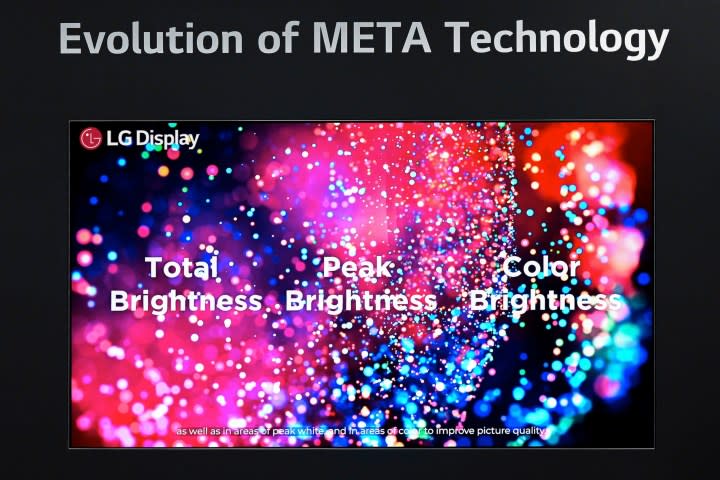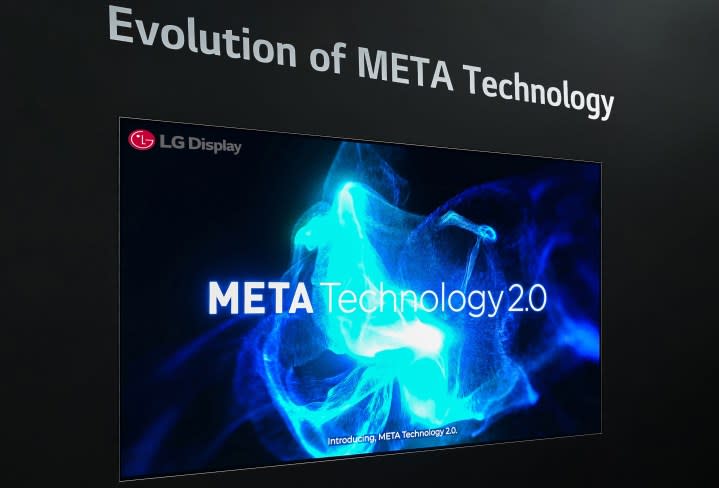Could LG’s 3000-nit OLED finally end the brightness wars?
This article contains affiliate links; if you click such a link and make a purchase, Digital Trends and Yahoo Inc. may earn a commission.

Ever since OLED TV technology made its debut in 2007, manufacturers who don’t sell OLED TVs have been quick to point out that, compared to LED and QLED TVs, OLED displays simply can’t get bright enough to be viewed in brightly lit environments. Today, at CES 2024, LG Display (the LG division that designs and fabricates OLED TV panels) appears to have dispelled that talking point once and for all with its announcement that it has created a new generation of large-size OLED displays that can achieve 3,000 nits of peak brightness.
LG Display says this new benchmark for OLED brightness is the result of its continued development of its META technology, which combines an ultrathin layer of micrometer-scale lenses (micro lens array or MLA) with two custom display algorithms that manage brightness and detail. It calls the new version META Technology 2.0.
“META Technology 2.0 features 42% brighter images than conventional OLED displays to achieve 3,000-nit peak brightness,” according to LG Display’s press release. “As higher peak brightness ensures a more vivid viewing experience akin to what the human eye perceives, this marks the highest brightness level of any large-sized OLED panel yet.”

At CES 2024, LG Display is showing an 83-inch 4K OLED display based on META 2.0, but the group says it plans additional sizes and resolutions, including 55-, 65-, 77-, and 83-inch 4K OLEDs, as well as 77- and 88-inch 8K OLEDs.
While 3,000 nits sounds like a big number, it’s actually more impressive in context. In 2023, the brightest non-OLED TV had a maximum peak brightness of just 2,500 nits. However, LG Display is also taking this opportunity to change the brightness conversation in a way that may put non-OLED displays on the defense, by putting an emphasis on color handling.
It says that META Technology 2.0 achieves improved color brightness of up to 1,500 nits — 114% brighter than conventional OLEDs. The claim is that this is especially beneficial when watching HDR content, by making brighter areas appear brighter and darker areas appear darker. And speaking of darker areas, LG Displays also says that META 2.0 takes advantage of OLED’s pixel-level control to ensures consistent and accurate color expression regardless of brightness levels.
Finally, the division is touting META 2.0’s energy efficiency. Because OLED displays don’t require a dedicated backlight, they tend to be more energy efficient than competing display types. META 2.0 further improves that efficiency by 22%, according to LG Display.
As it turns out, you won’t have to wait long to see META 2.0 in action: LG Electronics, the LG subsidiary that actually sells TVs, has incorporated these new META 2.0 panels in its flagship 2024 OLED TVs. Caleb Denison has an excellent video from the floor of CES 2024 that explains this roll out in more detail and why, even though LG’s newest TVs will have META 2.0, they may not deliver on LG Display’s promise of 3,000 nits.
We certainly don’t expect companies like Hisense and TCL to stop promoting the brightness superiority of their mini-LED TVs — if anything, CES 2024 proves they’re going to double and triple- down on that message — but gone are the days when OLED TV owners needed to hide their TVs in darkened rooms to get the best picture quality. That era of the brightness wars has now come to a close.

